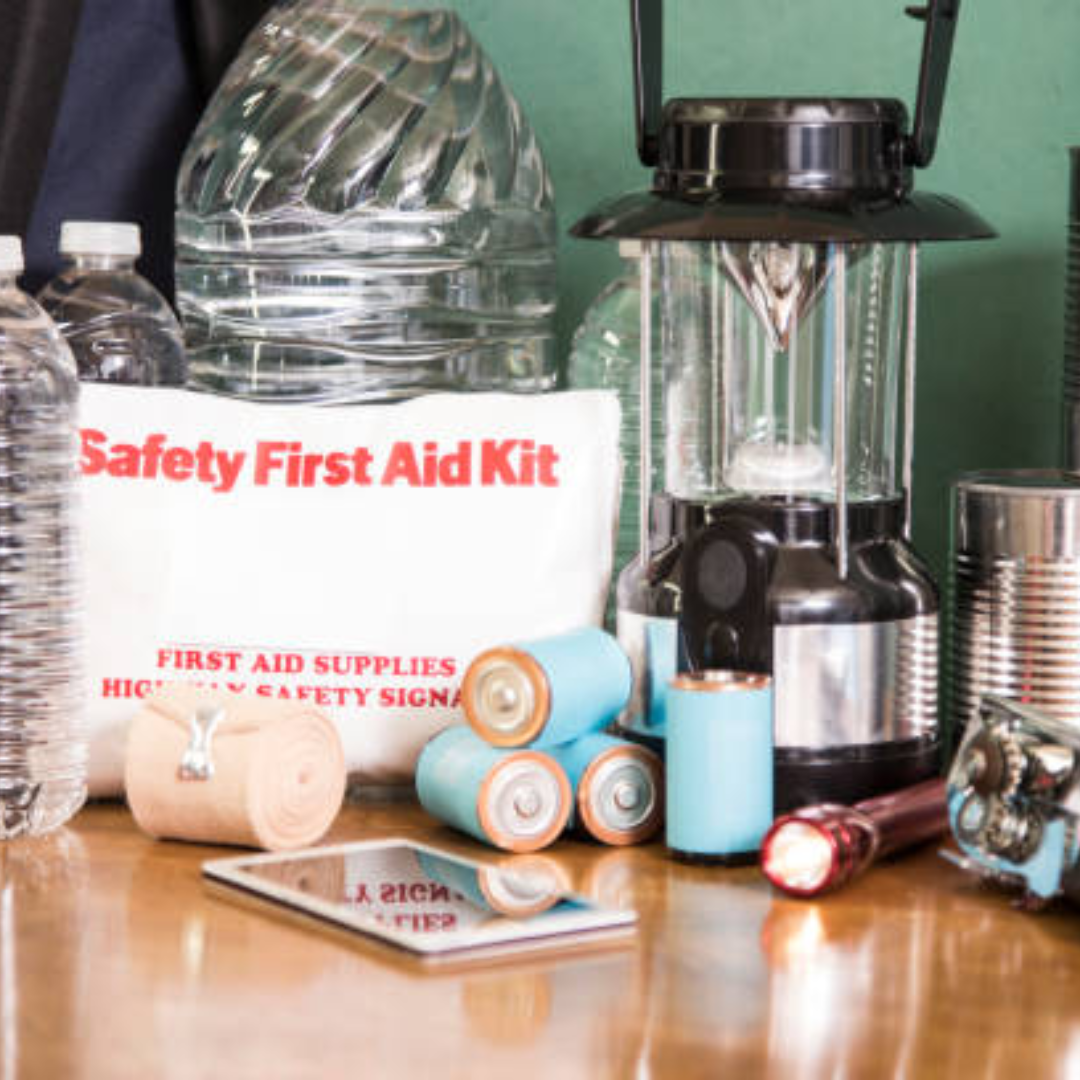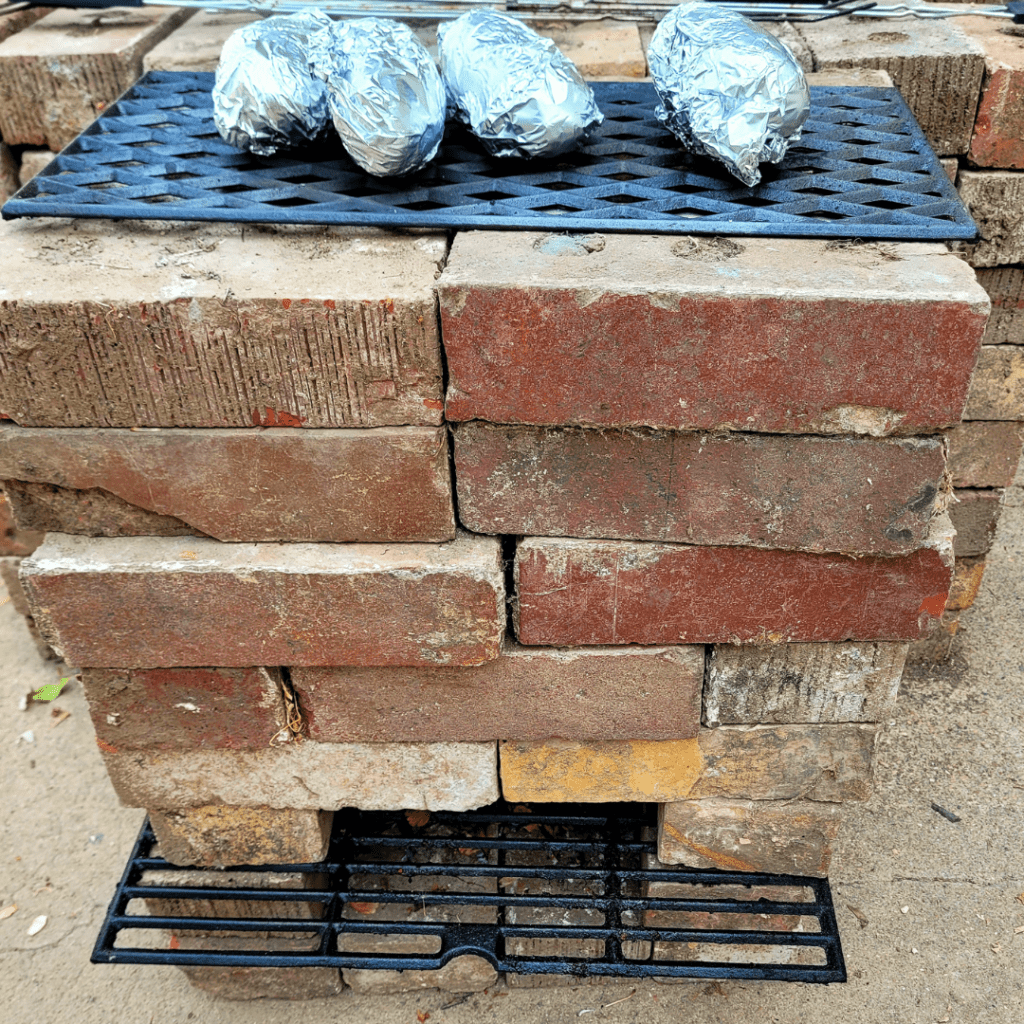Get These Vital Emergency Survival Equipment Now! Don’t wait until disaster strikes—ensure you have the essential survival gear to protect your family and yourself. From first aid kits to water purification and emergency tools, these must-have items keep you ready for any situation.
In our ever-changing world, readiness for emergencies is crucial. Whether it’s a sudden disaster, an unexpected turn of events, or something unforeseen, we all need to be prepared. The right emergency survival equipment can truly be a lifesaver when faced with tough times. So, let’s discuss what you should have on hand to stay safe and secure.
From the basics to more advanced tools, I’ll walk you through the essential items to include in your emergency preparedness kit. Let’s ensure you’re equipped and ready for whatever comes your way!
This is a pinnable post. Tap or hover over any image in this post to pin to your Pinterest Boards.
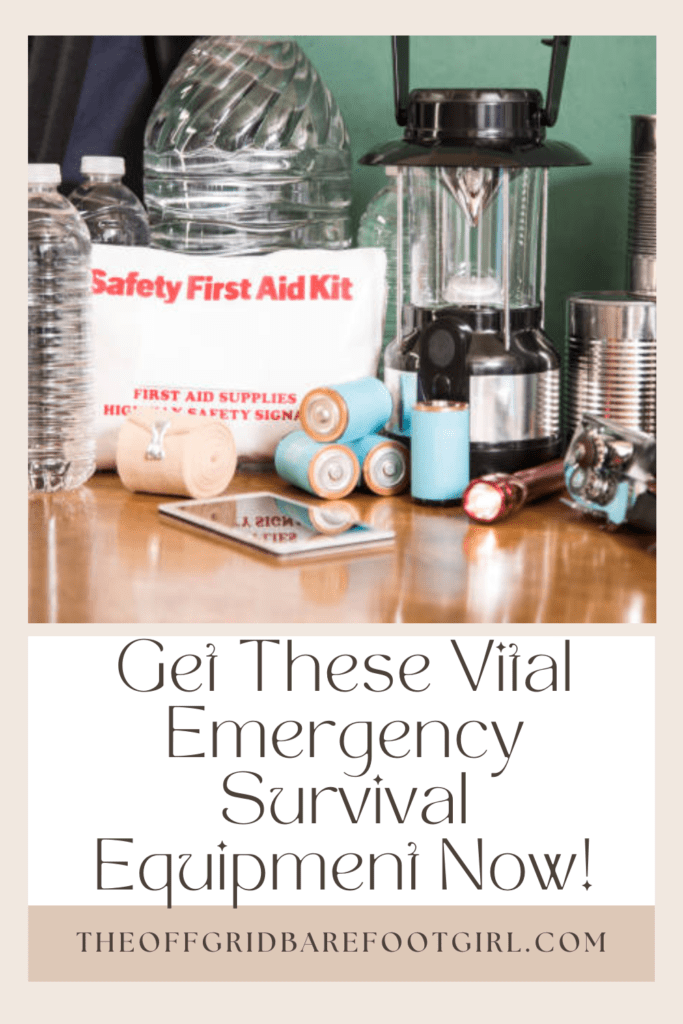
Understanding the Importance of Emergency Survival Equipment
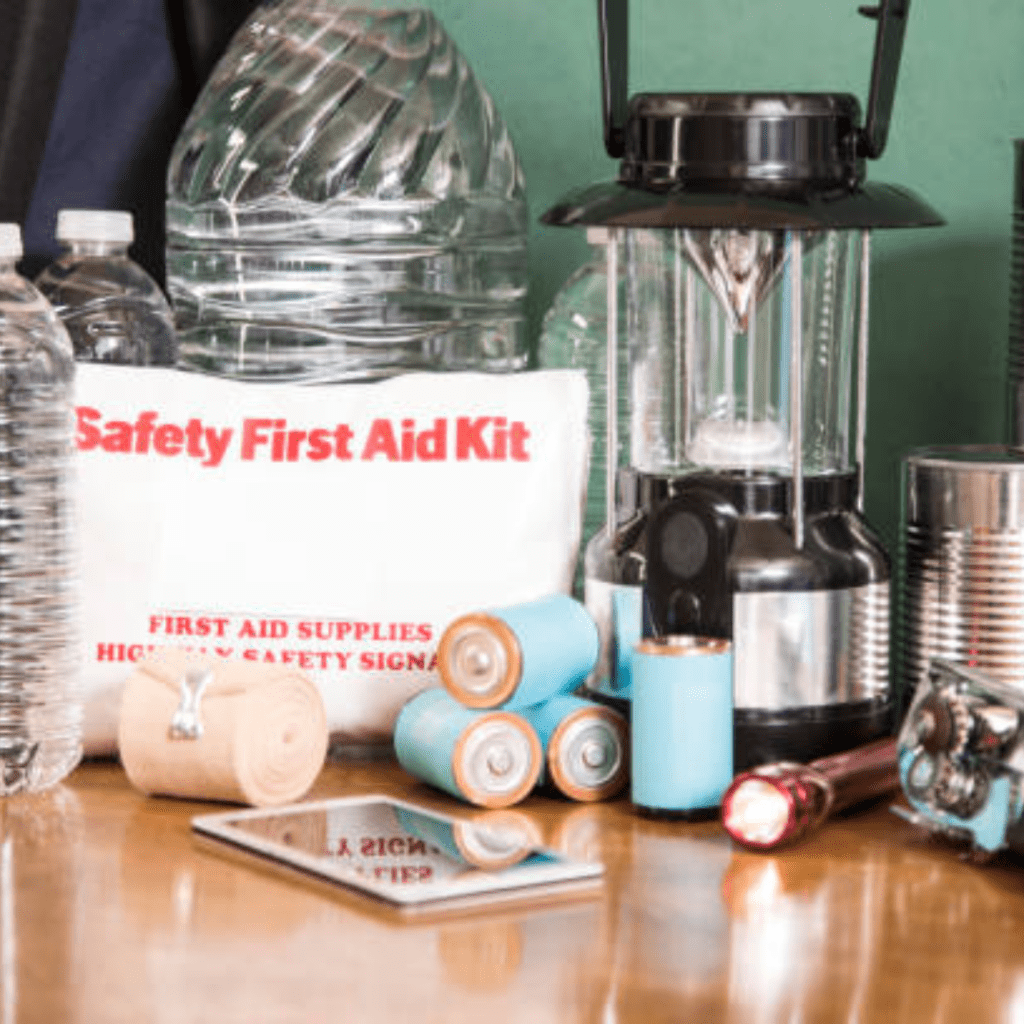
If you’re new to the idea of building an emergency survival kit, you’ve landed in the right place. Creating a kit might seem daunting at first, but with the right guidance, you’ll find it’s not only manageable—it’s also a crucial step in ensuring your safety and well-being in unexpected situations.
This guide is tailored specifically for beginners, breaking down the essential emergency survival equipment you’ll need to get started. Let’s discover what we need for our safety and preparedness together.
Understanding the Risks of Being Unprepared
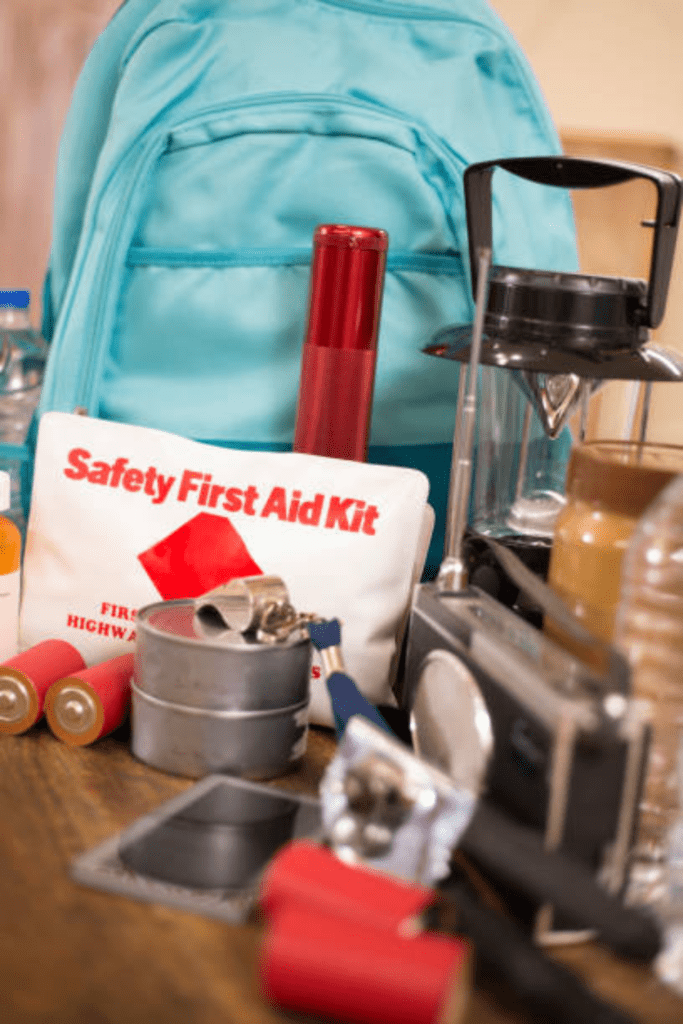
Imagine being stuck in a power outage, the grocery stores are closed, and you’re left with no supplies except a jar of pickles and some leftover spaghetti. Don’t be that person. Being unprepared in an emergency situation can leave you feeling more stranded than a castaway on a deserted island!
Envision you’re planning a serene hike through the woods, intending only to enjoy nature’s calm. However, nature is unpredictable. Suddenly, you’re facing a situation requiring you to stay overnight unexpectedly, or you find yourself in a disaster scenario. This is where emergency survival equipment becomes not just useful, but potentially lifesaving.
Having the right tools can mean the difference between a challenging adventure and a life-threatening ordeal. It’s about being prepared for the unexpected, ensuring you have the means to secure shelter, clean water, and aid in navigation back to safety.
Especially for beginners, understanding this importance is the first step towards prioritizing your safety and well-being, regardless of the circumstances. It’s about equipping yourself to face the unknown with confidence. I sure would not want to be on the next episode of The Day I Almost Died!
Vital Items for Emergency Survival Equipment
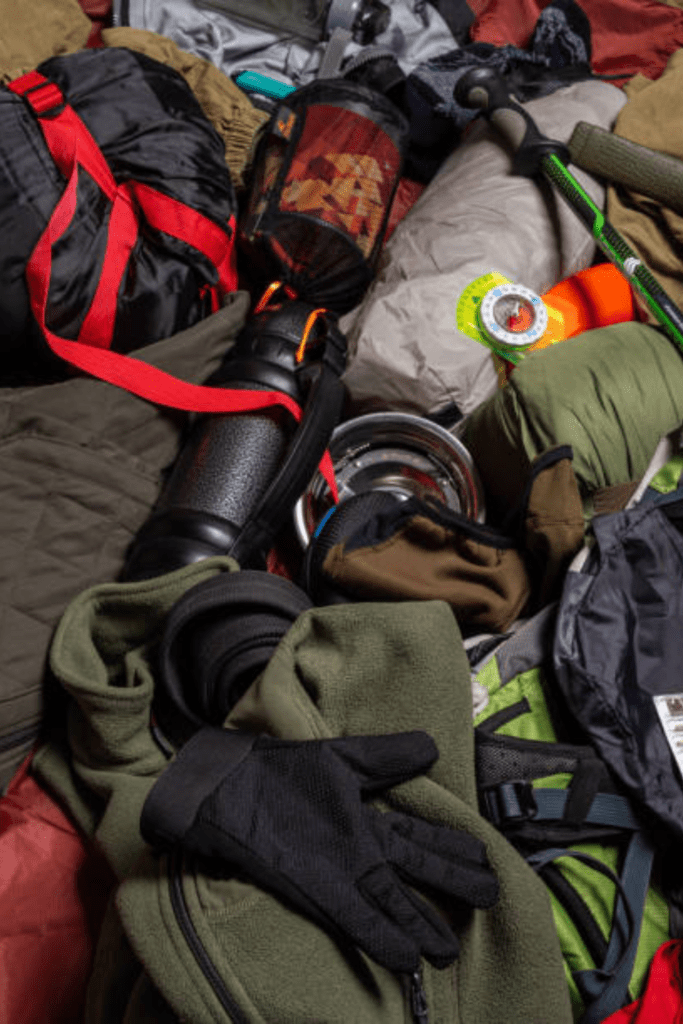
Starting your journey into preparedness can feel overwhelming, but it doesn’t have to be. Think of your emergency kit as your peace of mind, packed neatly in a bag. These essentials are your starting blocks to ensure safety and survivability in most situations.
When things go from bad to worse, having fire-starting tools, emergency blankets, and a portable stove can turn your survival game from zero to hero. Remember, you want to be prepared, not panicking when the going gets tough!
Water and Hydration Supplies
No emergency kit is complete without water—it’s literally your lifeline. Here’s the gist: aim for at least one gallon per person, per day. This quota is for drinking and sanitation. Not just any container will do; opt for durable, sealed vessels. And don’t forget purification methods. Tablets, portable filters, or boiling are extremely necessary. In a pinch, remember: staying hydrated is priority number one! Keep it simple, but sufficient.
You can last weeks without food, but only days without water. Prioritize packing water purification tablets and a reusable water bottle or hydration bladder. Consider a compact, portable water filter as well. Let’s go over important water supplies in detail.
Detailed List of Water and Hydration Supplies for Emergencies!
- Water:
- Store at least one gallon of water per person per day for at least three days, for drinking and sanitation.
- Consider storing additional water for pets and household needs.
- Water Containers:
- Food-grade containers or jugs for storing water.
- Portable water bottles or canteens for easy carrying.
- Collapsible water containers for compact storage.
- Water Purification:
- Water purification tablets or drops to disinfect contaminated water.
- Portable water filters or purifiers capable of removing bacteria, parasites, and viruses.
- Boil water over a heat source for at least one minute to kill harmful pathogens.
- Hydration Packs:
- Hydration backpacks or vests with built-in water reservoirs for hands-free hydration.
- Hydration bladders or reservoirs are compatible with backpacks for outdoor activities.
- Water Filtration Systems:
- Gravity-fed water filtration systems for purifying large quantities of water.
- Pump-action water filters for outdoor use or emergency situations.
- Straw-style water filters for individual use directly from water sources.
More Important Water and Hydration Supplies!
- Water Storage Solutions:
- Rain barrels or water storage tanks for collecting and storing rainwater.
- Water bricks or stackable water storage containers for compact storage.
- Underground cisterns or water storage systems for long-term water supply solutions.
- Water Conservation and Recycling:
- Water conservation kits include low-flow faucets, showerheads, and toilet flush systems.
- Greywater recycling systems for reusing water from sinks, showers, and laundry for non-potable purposes.
- Water Testing Kits:
- Water testing kits for monitoring water quality and ensuring safety.
- Pool test kits for detecting contaminants and maintaining water quality in swimming pools or hot tubs used for emergency water supply.
- Water Storage Accessories:
- Water preservatives or stabilizers for extending the shelf life of stored water.
- Siphon pumps or water extraction tools for accessing water from large containers or tanks.
- Water storage racks or shelving units for organizing and optimizing water storage space.
- Educational Resources:
- Manuals or guides on water purification methods and emergency water treatment.
- Training courses or workshops on water conservation and emergency preparedness.
Remember to regularly check and rotate stored water to ensure freshness and effectiveness in case of emergencies. Additionally, consider the specific needs and requirements of your household or location when selecting water and hydration supplies.
Be sure to check out my additional posts regarding the importance of water for survival.
- Warning: Why You Need Whole Home Water Purification Now!
- Are Greywater Tanks the Key to Sustainable Living? Find Out Now!
- Understanding Water Purification Methods for Survival: Best Practices Explained
- Thirsty for Survival: Expert Guide to Emergency Water Prep Tactics
Food and Nutrition
In any emergency, maintaining your energy and health is crucial, and that’s where food and nutrition come into play. Opt for non-perishable items like canned goods, dried fruits, nuts, and energy bars. These foods are not only lightweight, but also packed with the calories and nutrients you need to stay energized. If you want to be extra prepared, include ready-to-eat meals that only need hot water.
Keep in mind the importance of variety and balance. Including a mix of protein, carbs, and fats can help keep spirits high and bodies strong, even in the toughest of times. Remember, your food selection should be as resilient as your spirit in an emergency.
Detailed List of Food and Nutrition for Emergencies!
- Non-Perishable Foods:
- Canned fruits and vegetables.
- Canned meats (such as tuna, chicken, or ham).
- Canned soups, stews, and chili.
- Canned beans and legumes.
- Canned or jarred sauces (such as pasta sauce).
- Canned or dried fruits (such as applesauce, raisins, or dried apricots).
- Canned or powdered milk.
- Canned or dried nuts and seeds.
- Grains and Carbohydrates:
- Rice (white or brown).
- Pasta (including spaghetti, macaroni, and noodles).
- Rolled oats or instant oatmeal.
- Flour (all-purpose or whole wheat).
- Cornmeal or polenta.
- Crackers or rice cakes.
- Tortillas or flatbreads.
- Protein Sources:
- Dried beans (such as black beans, kidney beans, or lentils).
- Peanut butter or other nut butter.
- Dried or canned fish (such as tuna, salmon, or sardines).
- Beef jerky or other dried meats.
- Shelf-stable tofu or tempeh.
- Protein bars or meal replacement bars.
- Fats and Oils:
- Cooking oil (such as vegetable oil, olive oil, or coconut oil).
- Butter or margarine (if stored properly).
- Fruits and Vegetables:
- Dried fruits (such as raisins, apricots, or cranberries).
- Freeze-dried fruits and vegetables.
- Fruit cups or pouches (in water or juice, not syrup).
- Shelf-stable fruit and vegetable juices.
More Important Food and Nutrition for Emergencies!
- Comfort Foods and Snacks:
- Crackers or rice cakes.
- Granola bars or cereal bars.
- Popcorn (unpopped kernels for cooking).
- Chocolate or candy (for morale).
- Instant pudding or gelatin mixes.
- Special Dietary Needs:
- Gluten-free grains and products for those with gluten intolerance or celiac disease.
- Lactose-free or dairy-free alternatives for those with lactose intolerance or dairy allergies.
- Low-sodium or salt-free options for those on restricted salt diets.
- Infant and Baby Food:
- Baby formula (powdered or liquid).
- Jarred baby food or pouches.
- Baby cereal or oatmeal.
- Nutrition Supplements:
- Multivitamins or individual vitamin supplements.
- Protein powders or meal replacement shakes.
- Electrolyte replacement drinks or powder mixes.
- Food Preparation and Cooking Supplies:
- Manual can opener (if using canned foods).
- Portable camping stove or campfire cooking equipment.
- Disposable plates, bowls, and utensils.
- Aluminum foil, plastic wrap, and resealable bags for food storage.
Remember to regularly check expiration dates and rotate food supplies to maintain freshness and quality. Additionally, consider individual dietary preferences, allergies, and medical conditions when selecting emergency food supplies.
I have many posts I have written regarding information about stockpiling your pantry with emergency foods for you to check out!
- Survival Foods That Will Last Forever in Your Pantry
- How to Stock a Vegan Pantry: Must-Have Vegan Staples
- How to Stock a Working Pantry: Plus Tips to Use Your Stockpile
- Best Emergency Food Suppliers to Stockpile Your Survival Pantry
- Surviving the Unexpected: How to Plan a 6-Month Food Supply
- Surprising Ways to Use Powdered Milk in Your Recipes
- SHTF Prepper’s Pantry List: Apocalypse-Proof Your Food Supply Now!
- Practical Pantry Prepper: Essential Guide
- How to Make Hardtack Survival Biscuits
- Stockpiling MRE Meals for Survival: Prep Your Pantry
- 10 Ways to Save Money on Groceries During Inflation
- Best Foods to Stockpile for Survival Now: Prep Your Pantry
- SOS Mix is Essential for Your Survival Pantry
- Are Survival Food Kits Worth It? The Truth Revealed!
- Get Lockdown Ready: Best Dollar Tree Survival Items
- What Do Doomsday Preppers Stock? Prep Like a Prepper Now
Shelter and Warmth
In an emergency, protecting yourself from the elements is crucial. A lightweight, compact emergency tent or bivy sack should be on top of your list. These are designed to reflect your body heat, keeping you warm and dry. Don’t forget a sleeping bag or space blankets for extra insulation against cold nights.
Additionally, portable and reusable hand warmers can offer immediate relief in freezing conditions. Remember, it’s not just about surviving; it’s about maintaining your body’s core temperature to prevent hypothermia. With the right gear, you’ll be able to rest more comfortably and stay safer.
The basic rule? Stay dry and protected. Having the right emergency survival equipment can save your life! Don’t forget a compact, insulated sleeping pad and a reflective blanket to retain body heat!
Detailed List of Shelter and Warmth for Emergencies!
- Tents and Tarps:
- Lightweight camping tents suitable for emergency shelter.
- Waterproof tarps or emergency blankets for improvised shelters.
- Tent repair kits include patches, adhesive, and extra tent poles.
- Sleeping Gear:
- Sleeping bags that are rated for cold weather conditions.
- Emergency thermal blankets or sleeping bag liners for added warmth.
- Foam sleeping pads or inflatable camping mattresses for insulation from the ground.
- Clothing:
- Insulating layers such as fleece jackets, thermal underwear, and wool socks.
- Waterproof and windproof outer layers, such as rain jackets and pants.
- Hats, gloves, and scarves for head and hand protection against cold weather.
- Footwear:
- Sturdy hiking boots or waterproof shoes with good traction.
- Insulated boots or boot liners for cold weather conditions.
- Heating and Lighting:
- Portable camping stoves or backpacking stoves for cooking and heating water.
- Fuel for camping stoves such as propane, butane, or white gas.
- Portable heaters are suitable for indoor use in well-ventilated areas.
- Battery-operated or solar-powered lanterns, flashlights, and headlamps.
- Extra batteries or rechargeable battery packs for lighting devices.
More Shelter and Warmth for Emergencies!
- Fire-starting Tools:
- Waterproof matches or stormproof lighters.
- Fire starters such as tinder, fire starter sticks, or fire starter cubes.
- Magnesium fire starters or ferrocerium rods for reliable fire ignition.
- Emergency Shelter Kits:
- Pre-assembled emergency shelter kits including tents, sleeping bags, and other essential items.
- Shelter-in-place kits with supplies for fortifying and securing indoor spaces during emergencies.
- Portable Shelters:
- Pop-up canopy tents or instant shelters for quick setup and protection from the sun and rain.
- Portable gazebos or screen houses for extended outdoor stays in fair weather conditions.
- Insulation and Protection:
- Emergency shelter insulation materials such as emergency blankets, bubble wrap, or foam padding.
- Windbreaks or wind barriers that are made from tarps, plywood, or other sturdy materials.
- Tools and Equipment:
- Multi-tool or pocket knife for general repairs and utility tasks.
- Duct tape, zip ties, and rope for securing shelters and repairing equipment.
- Shovel or folding saw for clearing debris and building emergency shelters.
Remember to consider the specific climate and weather conditions of your area when selecting shelter and warmth supplies for emergencies. Additionally, practice setting up and using emergency shelter equipment before an actual emergency occurs to ensure familiarity and efficiency.
I have written more information regarding warmth and shelter safety.
- How to Build a No-Fail Fire Starter Survival Kit
- The Ultimate Camping Gear Checklist: Everything You Need for an Adventure
- Wood Burning Stoves for Off Grid Survival: My Top 5: This Is What Preppers Do
- How to Design Off Grid Power Systems for Your Homestead
- Buy or Die: Prepper Items You Need Now
- Why Doing a 1-Day No Power Survival Challenge Can Help Prepare Your Home for Emergencies
- How to Build an Off Grid Rocket Stove for Survival
- Embrace Your Inner Survivor: Master These Crucial Wilderness Survival Skills!
- What Should Be in A 72-Hour Survival Kit?
First Aid and Medical Supplies
Never overlook the significance of a well-stocked first aid kit. In emergencies, immediate medical care might not be available, making first aid supplies crucial. Your kit should have bandages, antiseptic wipes, scissors, tweezers, and pain relievers at the very least.
Also, consider personal medications and a booklet on basic first aid procedures. It’s not just about having the supplies; knowing how to use them can make all the difference.
A pre-packaged first aid kit can be a good start, but tailor it to your personal medical needs. Add extra bandages, antiseptic wipes, painkillers, and any prescription medications.
Remember, in the wild or during a disaster, these tools can be life-saving, so be sure to get the best quality items! You do not want to regret buying that cheap knife that breaks on you after a few uses when you need it most!
In an emergency, staying connected and knowing your way is crucial. For starters, invest in a reliable hand-crank or solar-powered radio to receive updates. Don’t overlook a sturdy, waterproof map and compass – these old-school tools don’t require batteries and can be lifesavers when gadgets fail. A whistle can also be a lifesaver for signaling help!
Also, a fully charged power bank can keep your smartphone operational, ensuring you can call for help or use GPS when needed. Remember, in the wilderness or during disasters, your ability to communicate and navigate effectively can make all the difference!
Building Your Emergency Kit on a Budget
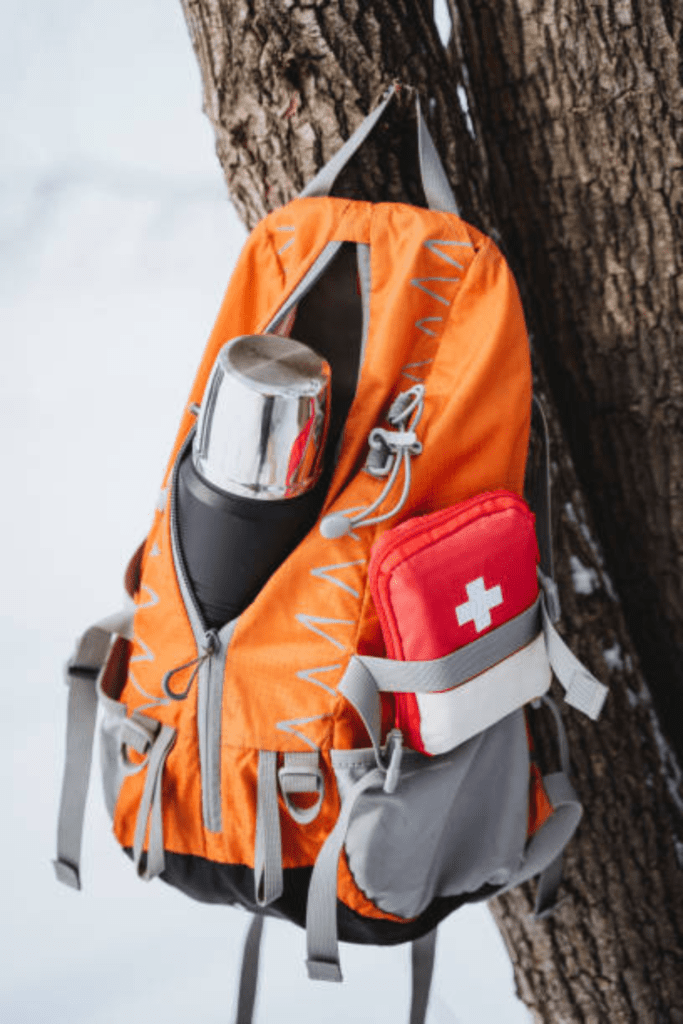
Crafting a well-equipped emergency kit doesn’t mean you have to break the bank.
Here Are Some Helpful Shopping Tips When Prepping Your Gear!
- Start by prioritizing essential items and gradually build up your kit.
- Look for deals at thrift stores and garage sales where you can find quality gear at a fraction of the cost.
- Consider DIY solutions for some items—like assembling your own first aid kit or creating waterproof matches.
- Remember, not everything needs to be brand new; focus on functionality.
- Lastly, spread out your purchases. You don’t have to buy everything at once!
By being strategic about when and where you shop, you can assemble a comprehensive emergency kit without straining your wallet. In the end, preparedness is about safety, not spending.
Key Considerations When Selecting Vital Emergency Survival Equipment
Selecting the right emergency equipment can be a bit overwhelming, but keeping a few key considerations in mind simplifies the process.
- First, think about versatility; choose items that serve multiple purposes to save space and weight.
- Durability is another critical factor; your gear should withstand harsh conditions.
- Don’t forget about the ease of use—when under stress, complicated gear can become a hindrance rather than a help.
- Weight is also essential; you’ll likely be carrying this equipment, so opt for lightweight and compact items when possible.
- Lastly, consider your specific environment; needs can vary greatly depending on your location.
- Keep it simple, focus on essentials, and choose quality over quantity to build a reliable emergency kit.
Conclusion
In conclusion, remember that stepping into the world of emergency preparedness can initially seem daunting, but it’s all about taking that first step. Start small, focusing on the essentials I’ve discussed, and gradually build your kit to suit your specific needs. The goal isn’t to have everything overnight, but to develop a readiness that grows over time. Stay informed, stay prepared, and most importantly, stay safe. Your emergency survival kit could one day make all the difference!
Make sure your home and family are fully equipped for any crisis by checking out The Complete Guide to Emergency Preparedness: Everything You Need to Thrive in Any Situation.
Resources: Here are some helpful resources for further information.
- Best Survival Gear to Have: The Ultimate Guide to Have – By The Survival Summit
- Top 10 Items to Add to Your Wilderness Survival Kit – By Brunton
- 55 Emergency Preparedness Items to Get You Thinking – By Modern Survival Blog
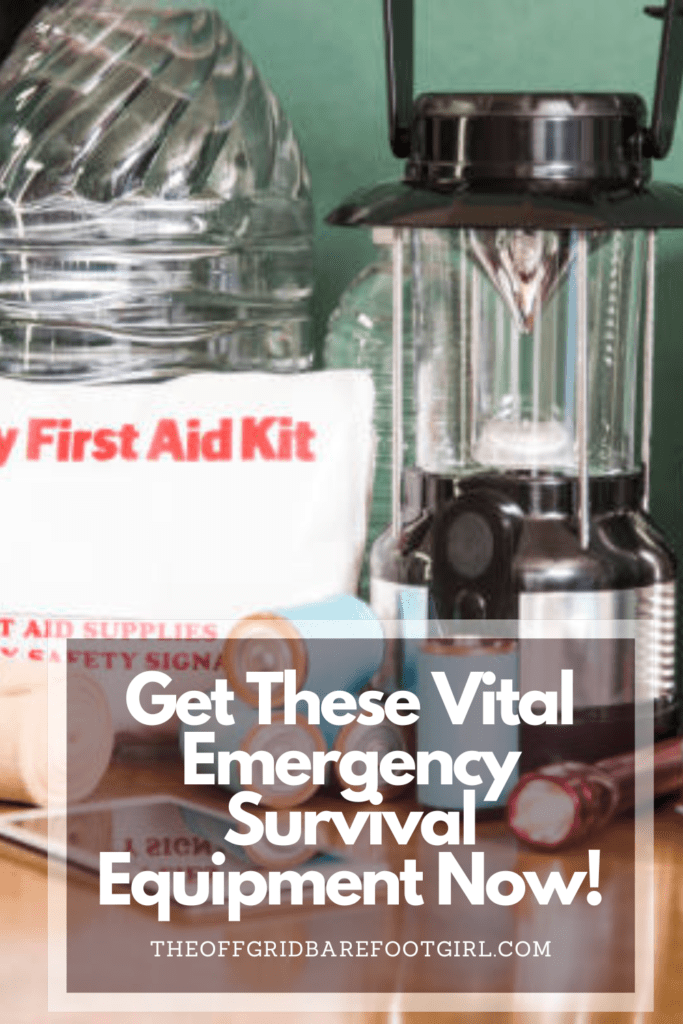
Frequently Asked Questions
1. What are the most important items to have in an emergency survival kit?
When it comes to putting together an emergency survival kit, there are a few key items that you definitely don’t want to leave out. First and foremost, water is absolutely essential for hydration and overall well-being. Make sure to have at least one gallon of water per person per day for at least three days. Next, non-perishable food such as canned goods, protein bars, and dried fruits are crucial for providing energy and sustenance during an emergency situation. A first aid kit with bandages, antiseptic wipes, pain relievers, and any necessary medications is also vital for treating injuries or ailments. Additionally, a flashlight with extra batteries, a whistle for signaling for help, a multipurpose tool like a Swiss Army knife, warm clothing and blankets, and important documents such as identification cards and insurance information should be included in your emergency survival kit.
2. How often should I update or check my emergency survival equipment?
It’s essential to regularly update and check your emergency survival equipment so that you can be sure everything is in working order when you need it. I recommend checking your supplies every few months to make sure nothing has expired or been damaged. This includes items like non-perishable food, water, batteries, first aid kits, flashlights, and any other essential items you may have in your emergency kit. It’s also a good idea to check the expiration dates on medications and replace them as needed. By staying on top of keeping your emergency supplies updated, you can rest assured knowing that you will be prepared for any situation that may arise at any time.
3. Can I customize my emergency survival kit based on my specific needs?
Absolutely! It’s crucial to customize your emergency survival kit based on your specific needs. Consider factors such as the climate you live in, any medical conditions you or your family members have, and the number of people who will be relying on the kit. For example, if you live in a cold climate, extra warm clothing and blankets may be essential. If someone in your household has allergies or requires certain medications, make sure to include those. Additionally, if you have pets, don’t forget to pack supplies for them as well. The key is to think about what you would need in various emergency scenarios and tailor your kit accordingly. This way, you’ll be well-prepared for any situation that may arise.
4. Are there any training courses or resources available to learn how to use emergency survival equipment effectively?
Yes, there are plenty of training courses and resources available to learn how to use emergency survival equipment. Many community centers, Red Cross chapters, and outdoor organizations offer classes on survival skills such as first aid, navigation, shelter building, fire starting, and more. Additionally, online platforms like YouTube have a wealth of tutorials and instructional videos demonstrating how to use various types of emergency equipment. It’s important to educate yourself on the proper usage of survival gear so you can effectively navigate emergency situations with confidence and preparedness. Whether you’re a seasoned outdoorsman or a beginner looking to enhance your skills, taking advantage of these training opportunities can greatly benefit you in times of crisis. Remember: knowledge is power when it comes to surviving in any situation!
Summary
I hope I have inspired you to help you prepare your emergency survival equipment with these helpful tips and products. Here are some other links you may be interested in reading!
Bartering: How To Negotiate Commodities with Astonishing Results!
Warning: Why You Need Whole Home Water Purification Now!
How to Design Off Grid Power Systems for Your Homestead
How Many Watts Does a Fridge Use? Energy Efficient Guide
The Best States for Off Grid Living: Unplugged and Thriving
Composting Toilet Systems Are Surging: Ditch Your Septic Tank Now!
Are Greywater Tanks the Key to Sustainable Living? Find Out Now!
How to Live Off-Grid: 11 Tips to Survive and Thrive!
Are Survival Food Kits Worth It? The Truth Revealed!
Do You Really Need Faraday Bags? The Shocking Truth Revealed!
The Best Doomsday Preppers Blogs to Follow Now Before SHTF!
The Ultimate Camping Gear Checklist: Everything You Need for an Adventure
The Ultimate Spring Cleaning House Checklist: Deep Clean with Me!
How Supporting Farmer’s Markets Makes a Difference
Eco-Friendly Christmas: How to Have an Eco-Friendly Christmas
How to Winterize Your Home: Prepare for Jack Frost’s Wrath!
Proven Hacks to Make Your Christmas Tree Survive
What Thanksgiving Teaches Us About Survival
Homeless Survival Hacks to Overcome Adversity
More Self-Sufficiency Posts!
Is Your Car Ready for Winter? The Ultimate Checklist for Your Winter Emergency Car Kit
What The Walking Dead Can Teach Us About Survival: The Walking Dead Survival Tactics
Get Lockdown Ready: Best Dollar Tree Survival Items
Understanding Water Purification Methods for Survival: Best Practices Explained
Thirsty for Survival: Expert Guide to Emergency Water Prep Tactics
The Benefits of Urban Homesteading: Revolutionize Your City Life
Practical Pantry Prepper: Essential Guide
How to Grocery Shop Once a Month
What Should Be in A 72-Hour Survival Kit?
Buy or Die: Prepper Items You Need Now
How to Learn 58 Self-Sufficient Skills Right Now
Road to Self-Sufficiency: How to Start Your Journey
If you were encouraged by this post, I invite you to check out my FREE Printables Page for fun free printables, planners, and charts.
ENTER MY FREE Printables Page HERE
Blessings,
The Off Grid Barefoot Girl

